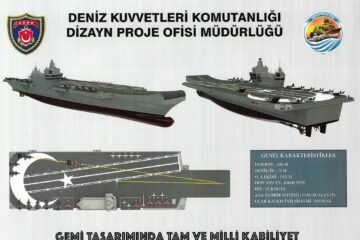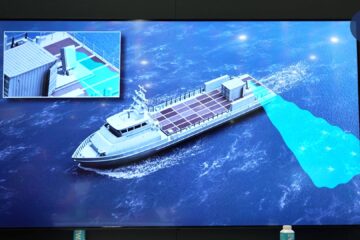Aircraft carriers are a strategic priority for the world’s leading navies. Experienced players such as the Royal Navy, French Navy (Marine Nationale) and Indian Navy are all in the process of bringing in new carriers. And Japan, South Korea and likely other countries are all taking steps to join the club. But nowhere is the capability gathering steam as much as in China. The Chinese Navy (PLAN) has already commissioned two carriers based on the Russian Admiral Kutzenov class. But their third carrier, known as Type-003, promises to take the PLAN to the next level.
Meanwhile the U.S. Navy, for decades the world leader in this technology, is also modernizing with a new class of super carrier. The first Ford Class ship, USS Gerald R. Ford (CVN-78) was commissioned in 2017. While it has suffered some teething problems it remains the largest and most modern carrier afloat.
The Type-003 is very close in size to the U.S. Navy’s carriers. And although the definition is vague, it seems fair to also describe it as a “super carrier”.
Fresh commercial satellite imagery from Kompsat, via Shadowbreak Inti., allows us to finally measure the size and layout of the Type-003. This permits a general high-level comparison to the Ford Class.
The imagery shows that it is approximately 320 meters (1,050 feet) long. This is about 13 meters (43 feet) shorter than the Ford Class. And it seems less than it sounds if you placed the two ships side by side.
The Chinese ship does have a narrower flight deck however, It’s width of about 73 meters (240 feet) is very similar to preceding Type-001 and Type-002 carriers. There may be logistical reasons for this, such as dry dock sizes. Or it may simply be that the Chinese planners were happy with the width of the current carriers.
Going Electromagnetic
The major step change over the current carriers however is in how aircraft will be launched. The new ship is CATOBAR (Catapult Assisted Take-Off But Arrested Recovery) while the first two are STOBAR (Short Take-Off But Arrested Recovery). Like the Ford Class, the Type-003 is believed to use an Electromagnetic Aircraft Launch System (EMALS) instead of a steam catapult. This should promise a faster launch rate. This is a cutting edge technology which has reportedly been less reliable so far on the Ford Class, although things are improving. Yet despite its challenges it is still seen as the way forward and we should not assume that the Chinese will have the same problems. For China it is pragmatic to go straight to EMALS and miss the steam catapult step.
The Type-003 has three catapults with two on the bow and one in a waist position. This is one fewer than the Ford Class which, like earlier American carriers with steam catapults, also has four.
Catapults, which are lacking on the current Chinese carriers, will allow new aircraft types to be carried. A new fixed-wing airborne early warning & control aircraft (AEW&C), the KJ-600, is expected to be aboard. This is, both in role and overall form, very similar to the E-2D Advanced Hawkeye. Other new aircraft are expected to include a carrier version of the FC-31 stealth fighter. A full-size mock-up of this has recently appeared at a test site in Wuhan. This will be generally equivalent of the Ford Classes’ F-35C Lightning-II. It has twin engines however, and possibly a larger internal weapons bay.
It is likely that this new plane will take some time to enter service so the Type-003 may start operations with a catapult capable version of the J-15 Flanker.
Fewer Aircraft Elevators
The Ford Class has three aircraft elevators (lifts), one less than the preceding Nimitz Class. Despite this the combination of these and the ELAMS should provide a greater sortie rate than the Nimitz Class. The Chinese ship however has only two. These are both rectangular and on the starboard side of the flight deck. Possibly because of the larger island sits between them (unlike on the Ford Class where it is at the stern), the forward lift is very close to the catapults. The blast deflector is right next to it, not forward of it. This may limit its use while aircraft are taking off.
However, on paper the Chinese carrier should have a larger usable deck area thanks to fewer lifts. This may not be seen as a wise trade-off as it will take the Chinese longer to move aircraft up from the hangar. Actually the answer may lie in the Soviet legacy. The Type-003 appears to have inherited its twin lift arrangement directly from the Russian Admiral Kutzenov class.
The island of the Type-003 has only just been placed on the deck in the past few days. It appears shorter than the earlier Chinese carriers but retains their single-level control tower. Above it however will be large phased array radars. This is like the Ford Class.
To summarize, the Type-003 is slightly smaller in overall dimensions. It has fewer catapults and fewer aircraft elevators, which may reduce sortie rates. In general the American ship is a bold evolutionary leap based on decades of operational experience. The Chinese ship on the other hand is a much more conservative step forward from the less experienced carrier operator. There’s no denying that in overall terms the Type-003 is going to be a very large carrier which should be extremely potent. But it may be held back slightly by some design choices which are routed in Soviet thinking.
There are of course many details which we still cannot know about the Type-003. Or the Fords Class in some cases. But ultimately their combat effectiveness, if it ever comes to that, will partly be in the crew and doctrine. The PLAN lacks the vast experience of the U.S. Navy, but it is all the same rapidly gaining experience. it has been operating carriers for nearly 10 years and is clearly heavily invested in making them a success.






